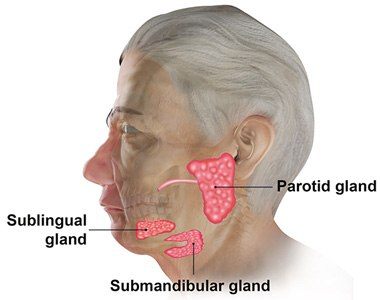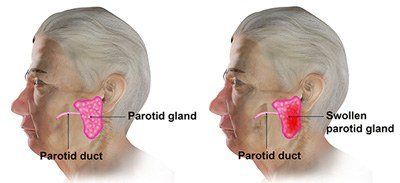Salivary Gland Conditions
Salivary Glands
What are salivary glands?

The mouth is the first station where food gets digested. This digestion takes place due to the secretion of saliva. Saliva also keeps the teeth healthy, the mouth moist and helps you swallow. It is secreted by 3 major pairs of salivary glands, namely the parotid glands, submandibular glands and sublingual glands. The submandibular glands are located a little below the mandible or jaw bone. Its secretions enter the oral cavity through narrow ducts into the floor of the mouth.
What are parotid glands? What is their function?
Parotid glands are two of the largest salivary glands present just in front of the ears. They secrete saliva into the mouth and help with mastication.

What are submandibular salivary glands?

The mouth is the first station where food gets digested. This digestion takes place due to the secretion of saliva. Saliva also keeps the teeth healthy, the mouth moist and helps you swallow. It is secreted by 3 major pairs of salivary glands, namely the parotid glands, submandibular glands and sublingual glands. The submandibular glands are located a little below the mandible or jaw bone. Its secretions enter the oral cavity through narrow ducts into the floor of the mouth.
Salivary Gland Tumors, Cysts
What is a salivary gland tumor?
A salivary gland tumor is a swelling caused by abnormal growth of tissue within the salivary gland or its duct.
What is a salivary gland cyst?
A salivary gland cyst is a sac-like structure that is filled with fluid, air, or other material within the salivary gland or its duct.
What are the signs and symptoms of a salivary gland tumor or cyst?
Most of the salivary gland tumors or cysts occur in the parotid gland. These masses are usually painless, slow growing, solitary nodules lying beneath the skin or mucosa. Cystic masses are soft while tumors are hard. Most of the masses are benign (non-cancerous) while a few may be malignant (cancerous). A cancerous mass may be painful if it invades the surrounding healthy tissue.
How are salivary gland tumors or cysts diagnosed?
CT scans and MRIs may be used to identify the tumor or cyst and determine its extent. A fine-needle aspiration may be used to identify the contents of the tumor or cyst.
How are salivary gland tumors and cysts treated?
Treatment of a benign tumor or cyst is through surgical excision. Care is taken to ensure that the tumor or cyst is completely excised as the chance of recurrence is very high following an incomplete excision. In the case of malignant masses, radiation therapy may be required along with surgical excision.
Salivary Gland Stones
What are salivary gland stones?
Salivary gland stones are calcified masses that form in a salivary gland or duct. These stones may block the flow of saliva into the mouth. Salivary gland stones are commonly found in the submandibular glands present in the floor of the mouth.
How are salivary gland stones formed?
Salivary gland stones are formed when your saliva becomes thick and there is accumulation of calcified deposits within the salivary gland or duct. The stones are composed mostly of calcium. Factors contributing to the development of salivary gland stones include dehydration, poor eating habits, trauma, and certain medications.
What are the signs and symptoms of a salivary gland stone?
Small salivary gland stones may not cause any symptoms, but if they become large enough to block a salivary duct, there could be associated pain and swelling. The pain may be intermittent initially, but could progressively worsen and cause infection of the salivary gland.
How are salivary gland stones diagnosed?
A physical exam may help your doctor palpate the stone within the gland or duct. An X-ray, CT scan, or ultrasound may also be ordered to aid in diagnosis. Sialography is a procedure that involves injection of a dye into the gland to better identify the stone on an X-ray.
How are salivary gland stones treated?
Removal of the salivary gland stone is the goal of treatment. If the stone is small, stimulating saliva flow by sucking on a sour candy or a lemon may result in spontaneous passing out of the stone. Your doctor may also try and massage the area to push the salivary gland stone out.
In case of a larger stone, your doctor may have to make a small incision in your mouth to take out the stone. Alternatively, an advanced technique known as sialendoscopy may be used to identify and remove salivary gland stones through the salivary gland opening without making any incisions. Antibiotics may also be prescribed if there is an infection caused by the salivary gland stone.






